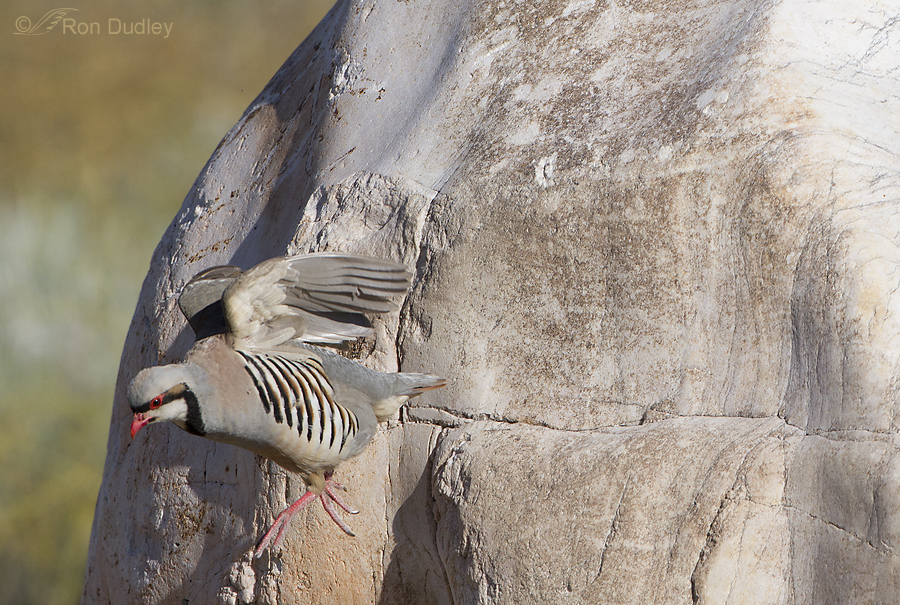Category: Upland Game Birds
Finally! – Another Cooperative Chukar
Some Very Odd-looking Pheasants
The Phantom Pheasant
Chukar Calling On One Foot

Chukars continue to be one of my preferred subjects during the winter and spring due to their distinctive and colorful plumage and their often comical behavior. They are abundant on Antelope Island and even somewhat approachable there – at least in comparison to their skittish and wily ways elsewhere (hunters consider them to be among the most challenging of upland game species).
Greater Sage Grouse In The Centennial Valley

I was driving the dirt roads while on the lookout for raptors (mostly) when out of the corner of my eye to the far right I saw (just barely) a flock of Mallards flush up from the barrow pit next to the road and just a few feet away. I gave them a quick glance and drove on but a couple of seconds later Mia hollered out from the back seat her patented “Stop, bird!”, which I immediately did. Turned out they weren’t Mallards, they were Sage Grouse – about a dozen of them.
Dusky Grouse
An Unlikely Alliance To Save The Greater Sage-Grouse

The Greater Sage-Grouse is a spectacular bird in many ways. They’re our largest grouse – males may approach 7 lbs. The dramatic breeding display of the males on the lek is mind-boggling. And to have one of these birds flush at your feet is literally a heart-stopping experience – something I know from experience.
But these birds are in great danger of extinction due to dramatic loss of habitat.
Chukar Free Fall
Plumage-challenged Chukar
Chukar Served With Black Mustard
Chukar – Wing Stretch On Tippytoes
Chukars Descending
I’ve mentioned before how very reluctant Chukars are to fly. They much prefer to scurry away through the grasses whenever they feel insecure or threatened.
And that reluctance also applies when they’re ready to leave an elevated perch. They’ll nearly always find a way to scramble down a big rock rather than fly from it like most other birds would. That tendency was demonstrated to me twice yesterday morning on Antelope Island.
Gray Partridges In Northwest Montana
The Gray Partridge has a fairly limited range in North America and most folks don’t get to see them so I thought some of my readers might be interested in a post on the species. This bird prefers the grasslands and grainfields of our northern wheat-belt so they’re fairly common on our family farm in northwest Montana.
Gray Partridges are often called Hungarian Partridges, or “Huns” for short.
Chukar Contrasts
Early last Sunday morning was a good time for Chukars on Antelope Island. It was too early for the weekend crowds who were mostly still home snoozing away, the light was great and the Chukars cooperative.
Finally! – Another Cooperative Chukar
Some Very Odd-looking Pheasants
The Phantom Pheasant
Chukar Calling On One Foot

Chukars continue to be one of my preferred subjects during the winter and spring due to their distinctive and colorful plumage and their often comical behavior. They are abundant on Antelope Island and even somewhat approachable there – at least in comparison to their skittish and wily ways elsewhere (hunters consider them to be among the most challenging of upland game species).
Greater Sage Grouse In The Centennial Valley

I was driving the dirt roads while on the lookout for raptors (mostly) when out of the corner of my eye to the far right I saw (just barely) a flock of Mallards flush up from the barrow pit next to the road and just a few feet away. I gave them a quick glance and drove on but a couple of seconds later Mia hollered out from the back seat her patented “Stop, bird!”, which I immediately did. Turned out they weren’t Mallards, they were Sage Grouse – about a dozen of them.
Dusky Grouse
An Unlikely Alliance To Save The Greater Sage-Grouse

The Greater Sage-Grouse is a spectacular bird in many ways. They’re our largest grouse – males may approach 7 lbs. The dramatic breeding display of the males on the lek is mind-boggling. And to have one of these birds flush at your feet is literally a heart-stopping experience – something I know from experience.
But these birds are in great danger of extinction due to dramatic loss of habitat.
Chukar Free Fall
Plumage-challenged Chukar
Chukar Served With Black Mustard
Chukar – Wing Stretch On Tippytoes
Chukars Descending
I’ve mentioned before how very reluctant Chukars are to fly. They much prefer to scurry away through the grasses whenever they feel insecure or threatened.
And that reluctance also applies when they’re ready to leave an elevated perch. They’ll nearly always find a way to scramble down a big rock rather than fly from it like most other birds would. That tendency was demonstrated to me twice yesterday morning on Antelope Island.
Gray Partridges In Northwest Montana
The Gray Partridge has a fairly limited range in North America and most folks don’t get to see them so I thought some of my readers might be interested in a post on the species. This bird prefers the grasslands and grainfields of our northern wheat-belt so they’re fairly common on our family farm in northwest Montana.
Gray Partridges are often called Hungarian Partridges, or “Huns” for short.
Chukar Contrasts
Early last Sunday morning was a good time for Chukars on Antelope Island. It was too early for the weekend crowds who were mostly still home snoozing away, the light was great and the Chukars cooperative.










